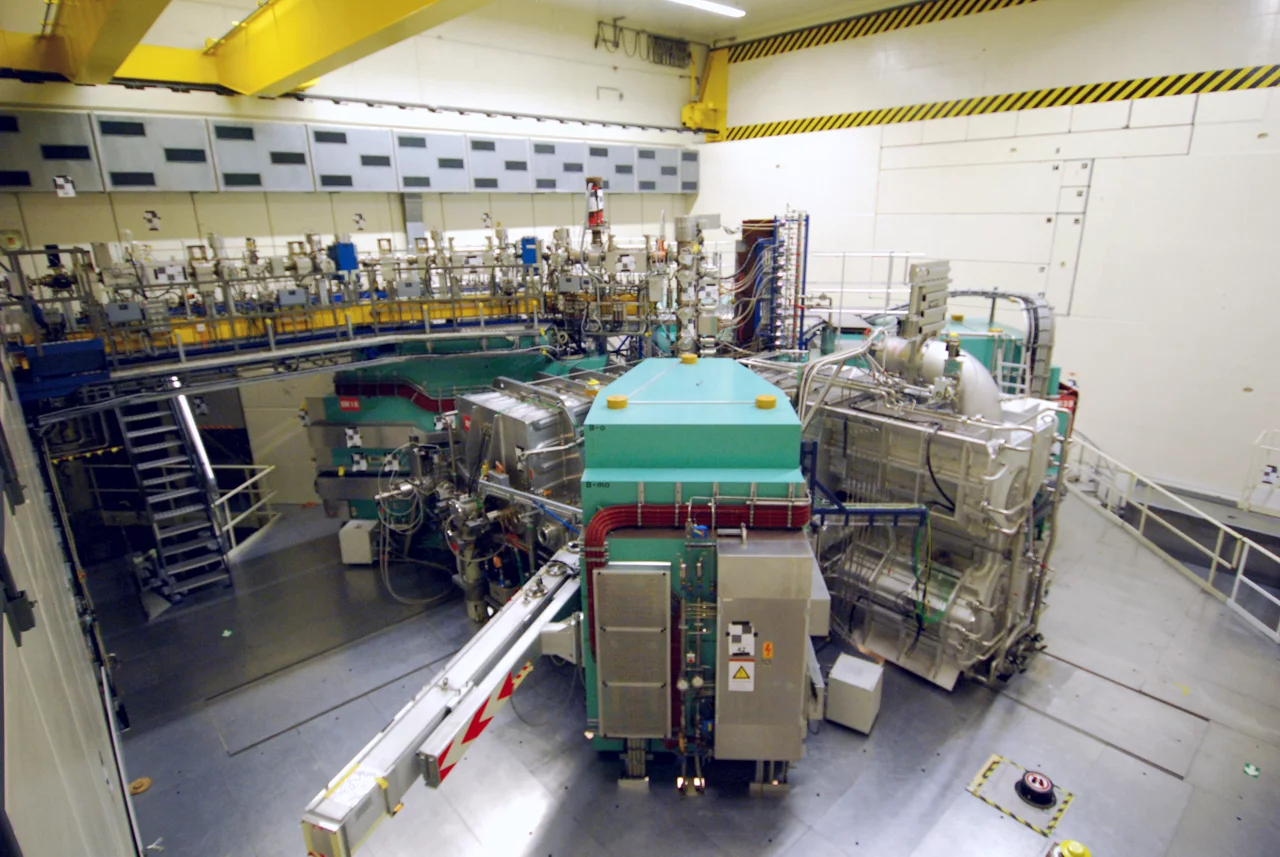The Injector 2 is a separated sector cyclotron that accelerates protons to a kinetic energy of 72 MeV.
It has been built by PSI to replace the multiparticle variable energy Injector 1 constructed by Philips, Eindhoven, Netherlands. Since the commissioning in 1984, Injector 2 provides high intensity, high quality beam of 72 MeV protons which is injected into the 590 MeV Ring cyclotron. A beam splitter in the transfer line allows to split off a fraction (up to 100 uA) of this beam for the production of radio isotopes, used mostly for medical purposes (PET scanning). The maximum proton current that has been extracted from Injector 2 is 2.7 mA. This corresponds to a beam power of almost 200 kW.
The Need for a Pre-accelerator
The four main magnets are the characteristic feature of the Injector 2. These large magnets are seperated from each other, thus leaving space for accelerating structures, called "resonators", injection and extraction elements. However, due to spatial limitations, it is not possible to locate a high current ion source in the center. Instead a proton beam of about 870 keV energy is provided by the Cockcroft-Walton pre-accelerator and injected by an axial injection line.
Acceleration structures
Protons pre-accelerated by the Cockcroft-Walton are injected vertically into the center of the Injector 2 cyclotron. A compact dipole magnet bends the beam into the median plane. Within the cyclotron, the protons are accelerated by two high frequency resonators operated at 50 MHz. These are supplemented by two additional resonators that run at 3 times the frequency, i.e., 150 MHz, originally designed to serve as so-called "flat top resonators". Today these former flat-tops are used as additional accelerating cavities, which results in a larger separation between turns. Furthermore, the number of turns required to accelerate the protons to extraction energy, is reduced. Both facts lead to lower proton losses when the the beam is extracted from Injector 2.
Flat-topping cavities are normally used to modify the wave-form of the normal accelerating structures. A sine-shaped waveform provides maximal voltage only for a short fraction of its period. The addition of a (phase-reversed) wave of a three times higher frequency ("third harmonic") of approximately 10% amplitude serves the purpose to "flatten" the top voltage and to keep the effective accelerating voltage constant over a large fraction of the period (large "phase range"). The purpose of this so-called "flat-topping" is to accelerate as many protons as possible to the exact same energy, thus keeping the energy spread of the beam as small as possible.
However it turned out that the Injector 2 cyclotron can be operated in a mode in which the strong space charge forces of the beam and the cyclotron magnetic field combine in a unique way so that the beam enters a metastable self-compactifying state where flat-topping is not required any more. The discovery of this operation mode in the Injector 2 was a little sensation in the community of cyclotron experts and the Injector 2 is still the only cyclotron worldwide that is able to make use of this operation mode. This self-compactifying effect allowed to reverse the phase of the flat-topping resonators and use them as additional accelerating structures ("anti-flat-tops"). But since these flat-top resonators could, when replaced by normal accelerating structures, help to increase the maximum beam current and/or to further reduce the losses, a project to exchange the flat-top by normal resonators is on-going.
Resonator Exchange Project
PSI follows an upgrade plan of the accelerator facility to achieve even higher beam currents. Currently, the two 150 MHz resonators are replaced by new 50 MHz resonators. The purpose of the new resonators is to allow an even better turn separation. Furthermore, the RF-amplifiers will be replaced by a more powerful system. This is also necessary, because of the lack of spare parts that not available on the market anymore. With the upgrade we want to reach our ultimate goal of 3 mA extracted from the cyclotron. This will result in more precise measurements in a shorter time.

